An All-Organic Flexible Visible Light Communication System
Abstract
1. Introduction
2. Materials and Methods
2.1. Flexible OPD Fabrication and Characterization
2.2. VLC System Layout
3. Results and Discussion
3.1. OPD Optolectronic Characterization
3.2. OLED Characterization
3.3. VLC System
4. Conclusions
Supplementary Materials
Author Contributions
Funding
Conflicts of Interest
References
- Khalid, A.M.; Cossu, G.; Corsini, R.; Choudhury, P.; Ciaramella, E. 1-Gb/s Transmission Over a Phosphorescent White LED by Using Rate-Adaptive Discrete Multitone Modulation. IEEE Photonics J. 2012, 4, 1465–1473. [Google Scholar] [CrossRef]
- Cossu, G.; Khalid, A.M.; Choudhury, P.; Corsini, R.; Ciaramella, E. 3.4 Gbit/s visible optical wireless transmission based on RGB LED. Opt. Express 2012, 20, B501–B506. [Google Scholar] [CrossRef] [PubMed]
- Tsonev, D.; Chun, H.; Rajbhandari, S.; McKendry, J.J.D.; Videv, S.; Gu, E.; Haji, M.; Watson, S.; Kelly, A.E.; Faulkner, G.; et al. A 3-Gb/s Single-LED OFDM-Based Wireless VLC Link Using a Gallium Nitride $murm LED$. IEEE Photonics Technol. Lett. 2014, 26, 637–640. [Google Scholar] [CrossRef]
- Afgani, M.Z.; Haas, H.; Elgala, H.; Knipp, D. Visible light communication using OFDM. In Proceedings of the 2nd International Conference on Testbeds and Research Infrastructures for the Development of Networks and Communities (TRIDENTCOM 2006), Barcelona, Spain, 1–3 March 2006; pp. 6–134. [Google Scholar]
- Salamandra, L.; Attanasio, V.; Susanna, G.; Penna, S.; Reale, A. Organic Visible Light Communication. In Proceedings of the 2014 16th International Conference on Transparent Optical Networks (ICTON), Graz, Austria, 6–10 July 2014. [Google Scholar]
- Muhammad, S.; Qasid, S.H.A.; Rehman, S.; Rai, A.B.S. Visible light communication applications in healthcare. Technol. Health Care 2016, 24, 135–138. [Google Scholar] [CrossRef] [PubMed]
- Ng, X.-W.; Chung, W.-Y. VLC-based medical healthcare information system. Biomed. Eng. Appl. Basis Commun. 2012, 24, 155–163. [Google Scholar] [CrossRef]
- Murai, R.; Sakai, T.; Kawano, H.; Matsukawa, Y.; Kitano, Y.; Honda, Y.; Campbell, K.C. A novel visible light communication system for enhanced control of autonomous delivery robots in a hospital. In Proceedings of the 2012 IEEE/SICE International Symposium on System Integration (SII), Fukuoka, Japan, 16–18 December 2012; pp. 510–516. [Google Scholar]
- Lv, H.; Feng, L.; Yang, A.; Guo, P.; Huang, H.; Chen, S. High Accuracy VLC Indoor Positioning System with Differential Detection. IEEE Photonics J. 2017, 9, 7903713. [Google Scholar] [CrossRef]
- Barman, A.D.; Halder, A. Indoor visible light communication with smart lighting technology. In Smart Photonic and Optoelectronic Integrated Circuits XIX; International Society for Optics and Photonics: San Francisco, CA, USA, 2017; Volume 10107, p. 101070W. [Google Scholar]
- Kim, D.R.; Yang, S.H.; Kim, H.S.; Son, Y.H.; Han, S.K. Outdoor Visible Light Communication for inter- vehicle communication using Controller Area Network. In Proceedings of the 2012 Fourth International Conference on Communications and Electronics, Hue, Vietnam, 1–3 August 2012; pp. 31–34. [Google Scholar]
- Farr, N.; Bowen, A.; Ware, J.; Pontbriand, C.; Tivey, M. An integrated, underwater optical/acoustic communications system. In Proceedings of the OCEANS 2010 IEEE Sydney, Sydney, Australia, 24–27 May 2010; pp. 1–6. [Google Scholar]
- Arredondo, B.; Romero, B.; Pena, J.M.S.; Fernández-Pacheco, A.; Alonso, E.; Vergaz, R.; de Dios, C. Visible light communication system using an organic bulk heterojunction photodetector. Sensors 2013, 13, 12266–12276. [Google Scholar] [CrossRef] [PubMed]
- Haigh, P.A.; Bausi, F.; Minh, H.L.; Papakonstantinou, I.; Popoola, W.O.; Burton, A.; Cacialli, F. Wavelength-Multiplexed Polymer LEDs: Towards 55 Mb/s Organic Visible Light Communications. IEEE J. Sel. Areas Commun. 2015, 33, 1819–1828. [Google Scholar] [CrossRef]
- Haigh, P.A.; Ghassemlooy, Z.; Rajbhandari, S.; Papakonstantinou, I. Visible light communications using organic light emitting diodes. IEEE Commun. Mag. 2013, 51, 148–154. [Google Scholar] [CrossRef]
- Zhang, S.; Tsonev, D.; Videv, S.; Ghosh, S.; Turnbull, G.A.; Samuel, I.D.W.; Haas, H. Organic solar cells as high-speed data detectors for visible light communication. Optica 2015, 2, 607–610. [Google Scholar] [CrossRef]
- Sajjad, M.T.; Manousiadis, P.P.; Chun, H.; Vithanage, D.A.; Rajbhandari, S.; Kanibolotsky, A.L.; Faulkner, G.; O’Brien, D.; Skabara, P.J.; Samuel, I.D.W.; et al. Novel Fast Color-Converter for Visible Light Communication Using a Blend of Conjugated Polymers. ACS Photonics 2015, 2, 194–199. [Google Scholar] [CrossRef]
- Kim, I.K.; Pal, B.N.; Ullah, M.; Burn, P.L.; Lo, S.-C.; Meredith, P.; Namdas, E.B. High-Performance, Solution-Processed Non-polymeric Organic Photodiodes. Adv. Opt. Mater. 2015, 3, 50–56. [Google Scholar] [CrossRef]
- Kielar, M.; Dhez, O.; Pecastaings, G.; Curutchet, A.; Hirsch, L. Long-Term Stable Organic Photodetectors with Ultra Low Dark Currents for High Detectivity Applications. Sci. Rep. 2016, 6, 39201. [Google Scholar] [CrossRef] [PubMed]
- Grimoldi, A.; Colella, L.; La Monaca, L.; Azzellino, G.; Caironi, M.; Bertarelli, C.; Natali, D.; Sampietro, M. Inkjet printed polymeric electron blocking and surface energy modifying layer for low dark current organic photodetectors. Org. Electron. 2016, 36, 29–34. [Google Scholar] [CrossRef]
- Nathan, A.; Ahnood, A.; Cole, M.T.; Lee, S.; Suzuki, Y.; Hiralal, P.; Bonaccorso, F.; Hasan, T.; Garcia-Gancedo, L.; Dyadyusha, A.; et al. Flexible Electronics: The Next Ubiquitous Platform. Proc. IEEE 2012, 100, 1486–1517. [Google Scholar] [CrossRef]
- Nakada, H. The Status of Development of Organic Light Emitting Diodes/Organic Thin-Film Transistors. J. Photopol. Sci. Technol. 2007, 20, 35–38. [Google Scholar] [CrossRef]
- Sirringhaus, H.; Tessler, N.; Friend, R.H. Integrated Optoelectronic Devices Based on Conjugated Polymers. Science 1998, 280, 1741–1744. [Google Scholar] [CrossRef] [PubMed]
- Baibarac, M.; Gómez-Romero, P. Nanocomposites based on conducting polymers and carbon nanotubes: From fancy materials to functional applications. J. Nanosci. Nanotechnol. 2006, 6, 289–302. [Google Scholar] [CrossRef] [PubMed]
- Logothetidis, S. Flexible organic electronic devices: Materials, process and applications. Mater. Sci. Eng. B 2008, 152, 96–104. [Google Scholar] [CrossRef]
- Krebs, F.C. Fabrication and processing of polymer solar cells: A review of printing and coating techniques. Sol. Energy Mater. Sol. Cells 2009, 93, 394–412. [Google Scholar] [CrossRef]
- Krebs, F.C.; Gevorgyan, S.A.; Alstrup, J. A roll-to-roll process to flexible polymer solar cells: Model studies, manufacture and operational stability studies. J. Mater. Chem. 2009, 19, 5442–5451. [Google Scholar] [CrossRef]
- Laskarakis, A.; Logothetidis, S. On the optical anisotropy of poly(ethylene terephthalate) and poly(ethylene naphthalate) polymeric films by spectroscopic ellipsometry from visible-far ultraviolet to infrared spectral regions. J. Appl. Polym. Sci. 2006, 99, 066101. [Google Scholar] [CrossRef]
- Logothetidis, S. Polymeric substrates and encapsulation for flexible electronics: Bonding structure, surface modification and functional nanolayer growth. Rev. Adv. Mater. Sci. 2005, 10, 387–397. [Google Scholar]
- Logothetidis, S.; Laskarakis, A. Towards the optimization of materials and processes for flexible organic electronics devices. Eur. Phys. J.-Appl. Phys. 2009, 46, 12502. [Google Scholar] [CrossRef]
- Haigh, P.A.; Ghassemlooy, Z.; Papakonstantinou, I.; Arca, F.; Tedde, S.F.; Hayden, O.; Leitgeb, E. A 1-Mb/s Visible Light Communications link with low bandwidth organic components. IEEE Photonics Technol. Lett. 2014, 26, 1295–1298. [Google Scholar] [CrossRef]
- Thai, P.Q. Real-Time 138-kb/s transmission using OLED with 7-kHz modulation bandwidth. IEEE Photonics Technol. Lett. 2015, 27, 2571–2574. [Google Scholar] [CrossRef]
- Chen, H.; Li, S.; Huang, B.; Xu, Z.; Li, W.; Dong, G.; Xie, J. A 1.9Mbps OFDM-based all-organic visible light communication system. In Proceedings of the 2016 IEEE International Conference on Communication Systems (ICCS), Shenzhen, China, 14–16 December 2016; pp. 1–6. [Google Scholar] [CrossRef]
- Haigh, P.A.; Bausi, F.; Ghassemlooy, Z.; Papakonstantinou, I.; Le Minh, H.; Fléchon, C.; Cacialli, F. Visible light communications: Real time 10 Mb/s link with a low bandwidth polymer light emitting diode. Opt. Express 2014, 22, 2830–2838. [Google Scholar] [CrossRef] [PubMed]
- Chen, H.; Xu, Z.; Gao, Q.; Li, S. A 51.6 Mb/s experimental VLC system using a monochromic organic LED. IEEE Photonics J. 2018, 10, 7901312. [Google Scholar] [CrossRef]
- Chvojka, P.; Dvorak, P.; Pesek, P.; Zvanovec, S.; Haigh, P.A.; Ghassemlooy, Z. Characterization of the Organic LED Based Visible Light Communications. In Proceedings of the 2016, IEEE Proceedings of the 10th International Symposium on Communication Systems, Networks and Digital Signal Processing (CSNDSP), Prague, Czech Republic, 20–22 July 2016. [Google Scholar] [CrossRef]
- Chen, H.; Xu, Z. OLED panel radiation pattern and its impact on VLC channel characteristics. IEEE Photonics J. 2018, 10, 7901410. [Google Scholar] [CrossRef]
- Available online: https://en.maritex.com.pl/product/attachment/41567/OLP-N6SA30.pdf (accessed on 7 September 2018).

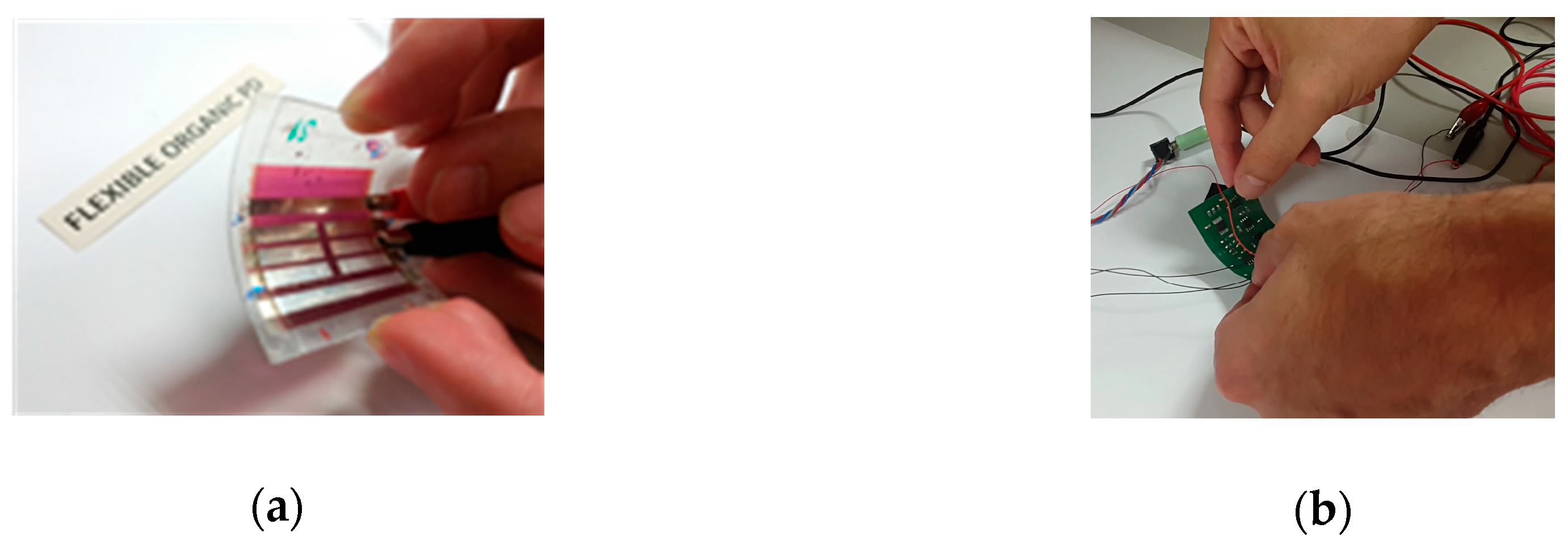
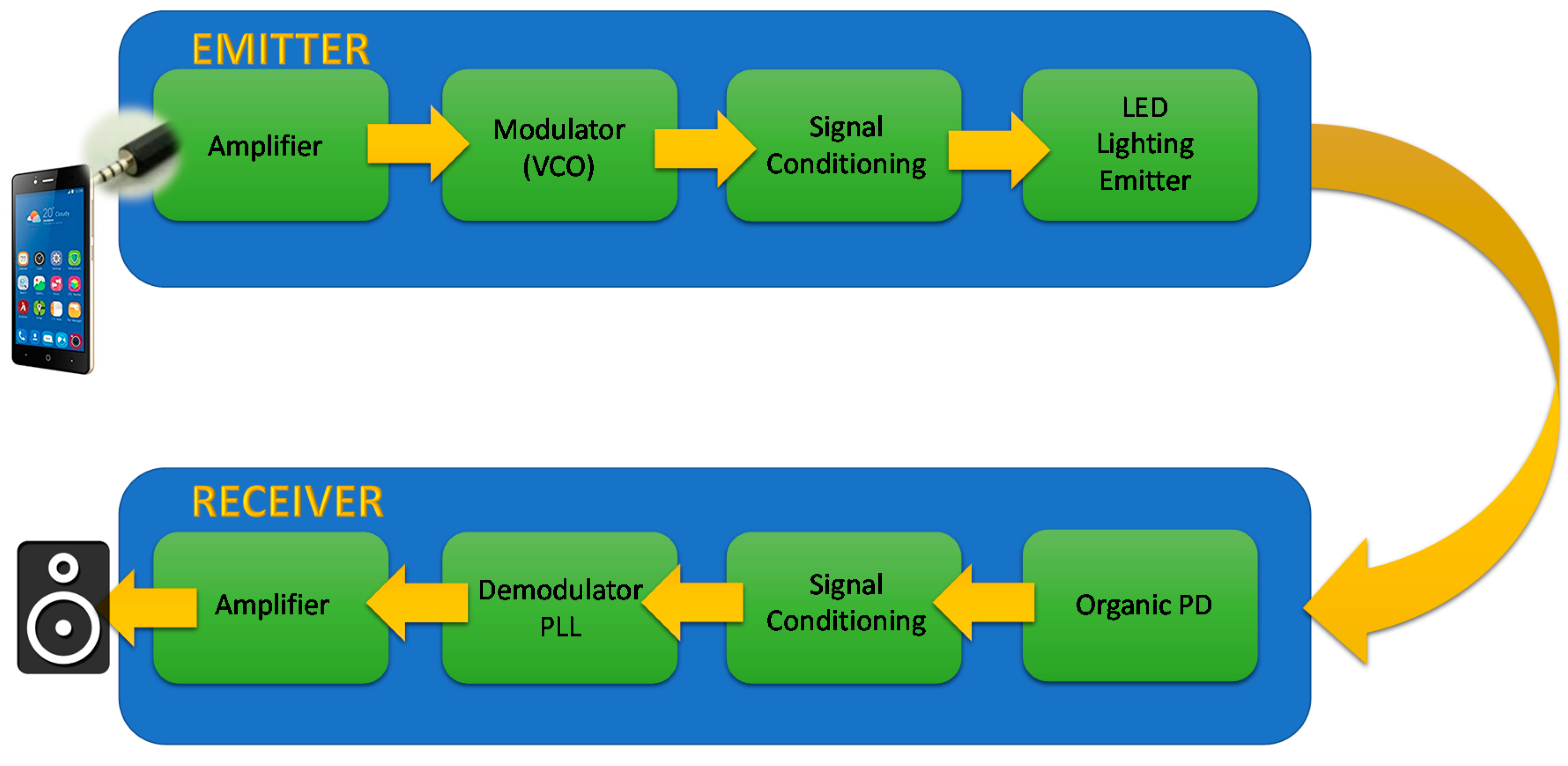
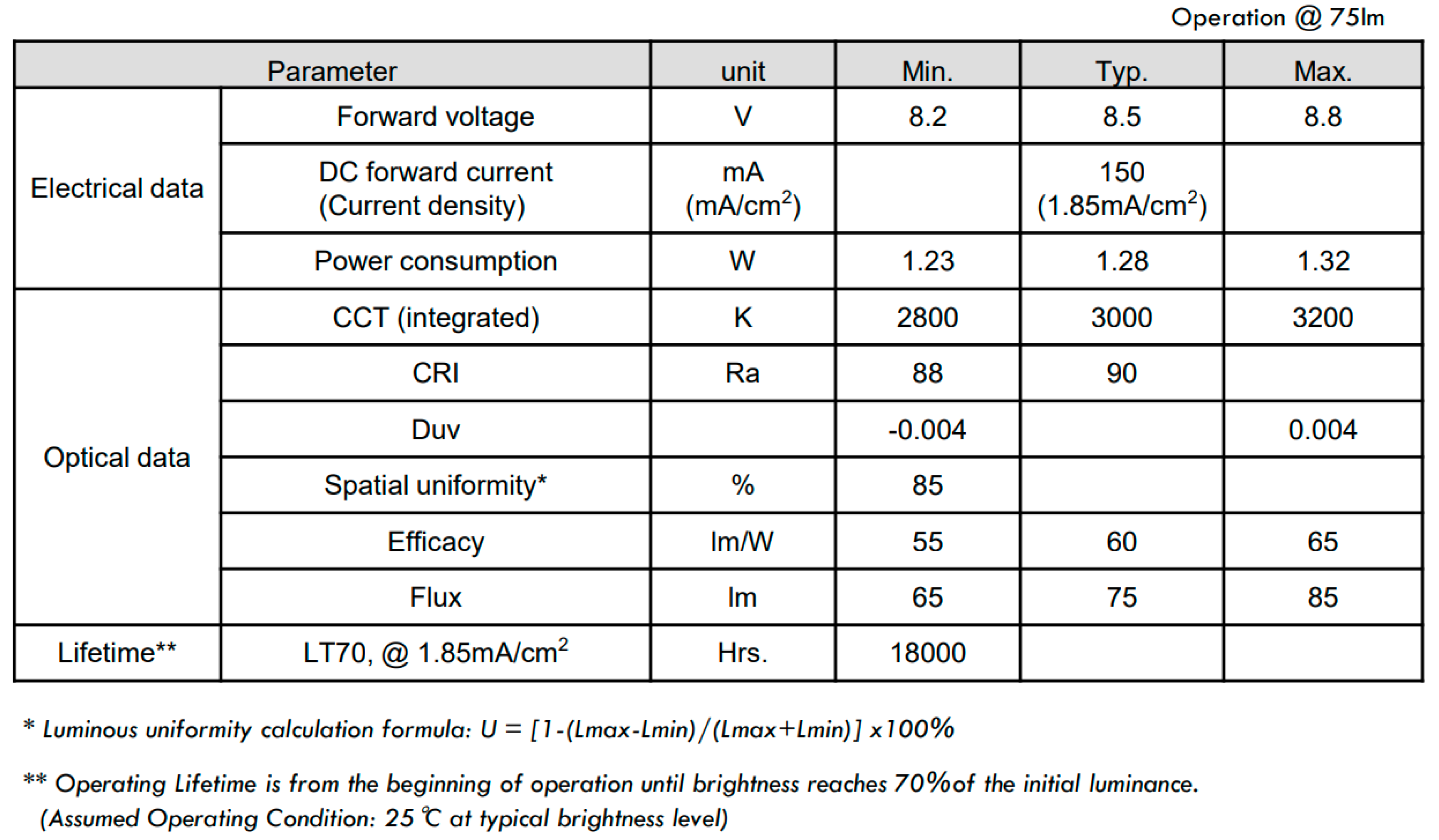

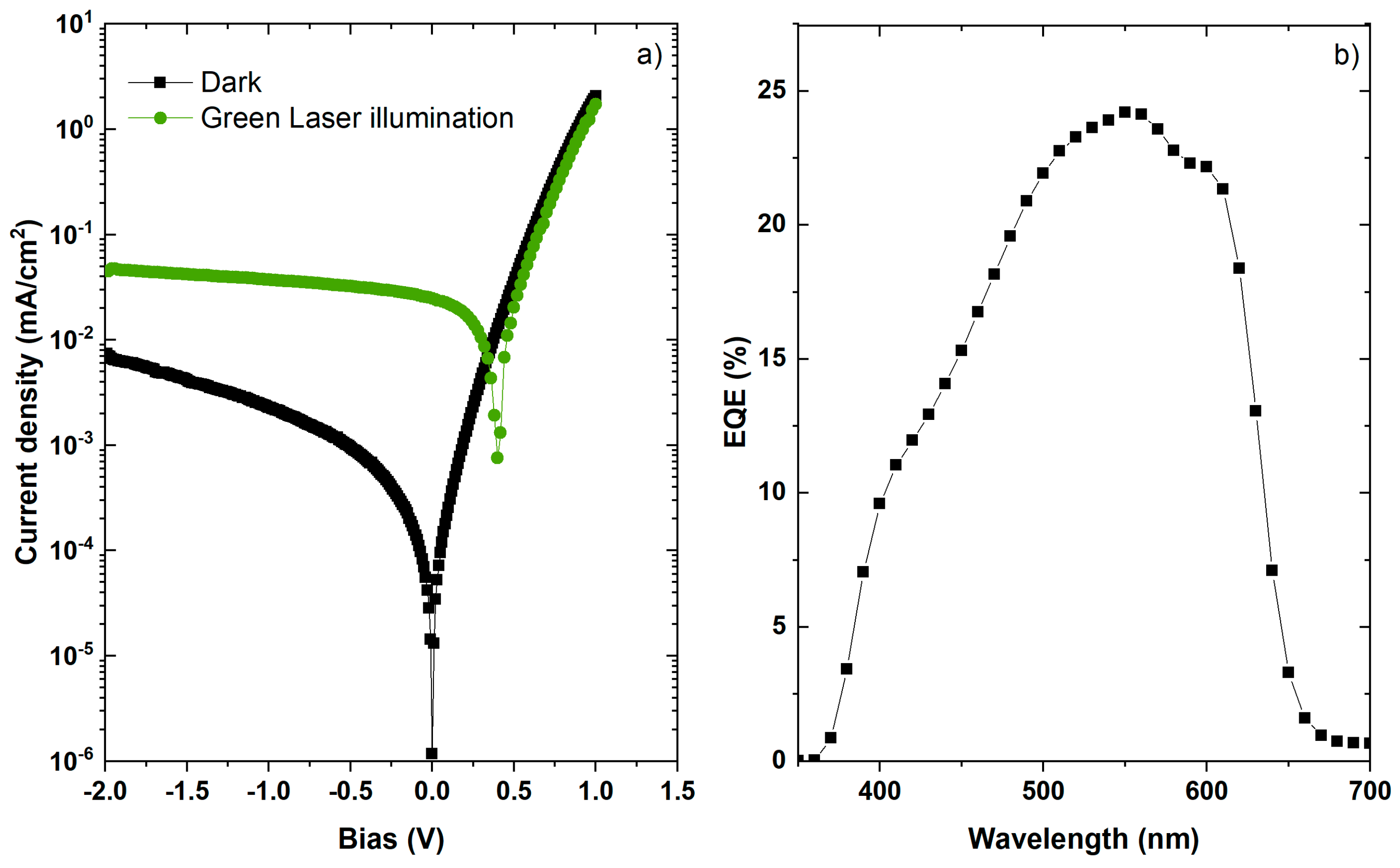
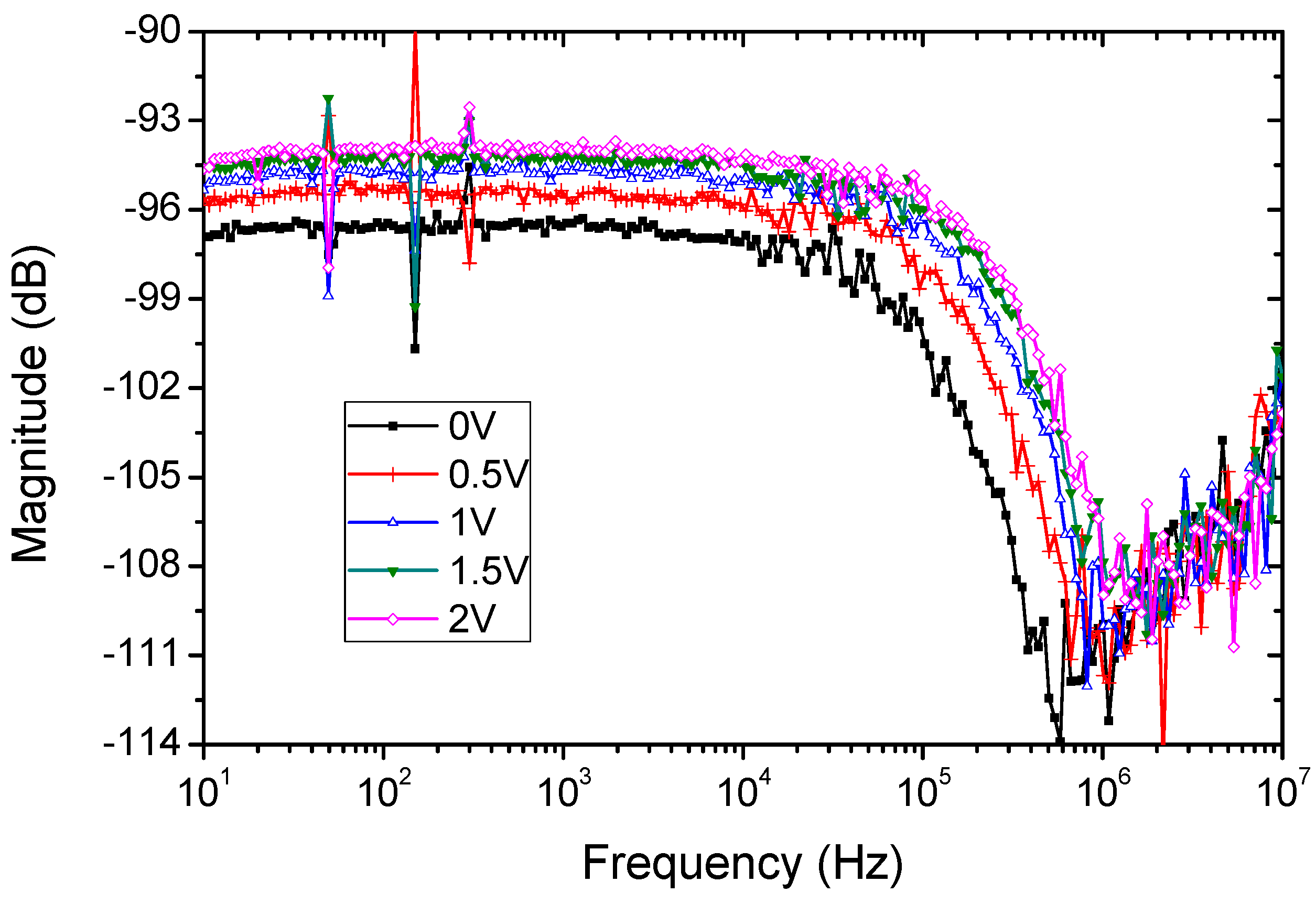
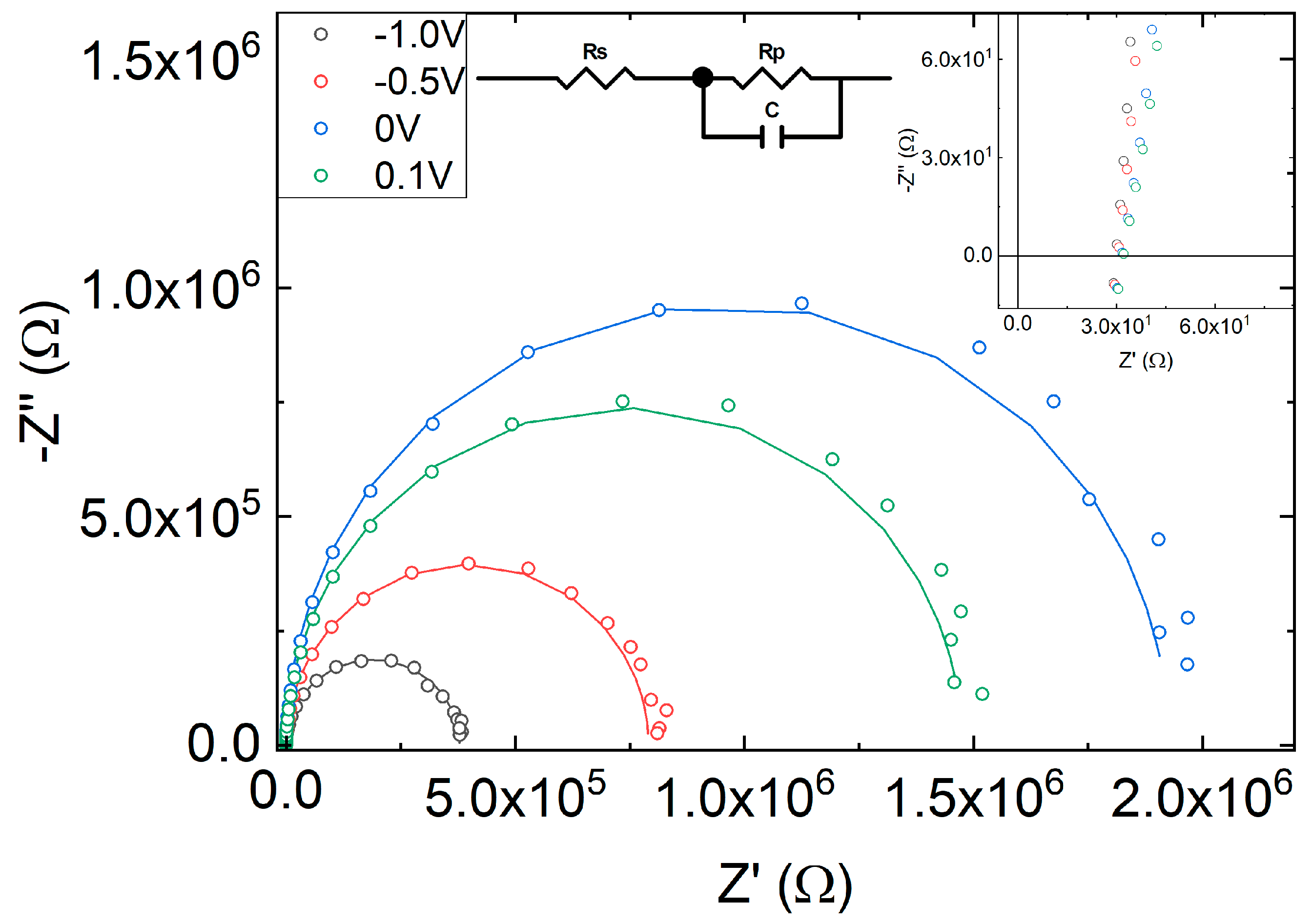
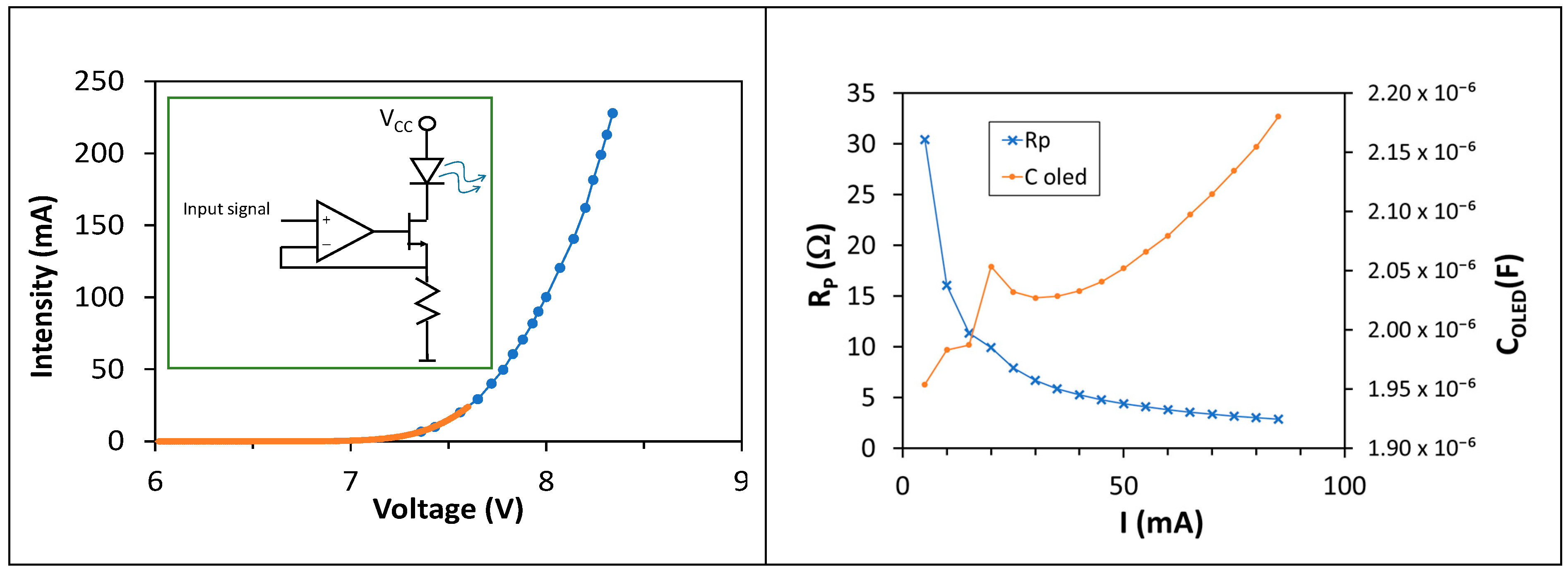
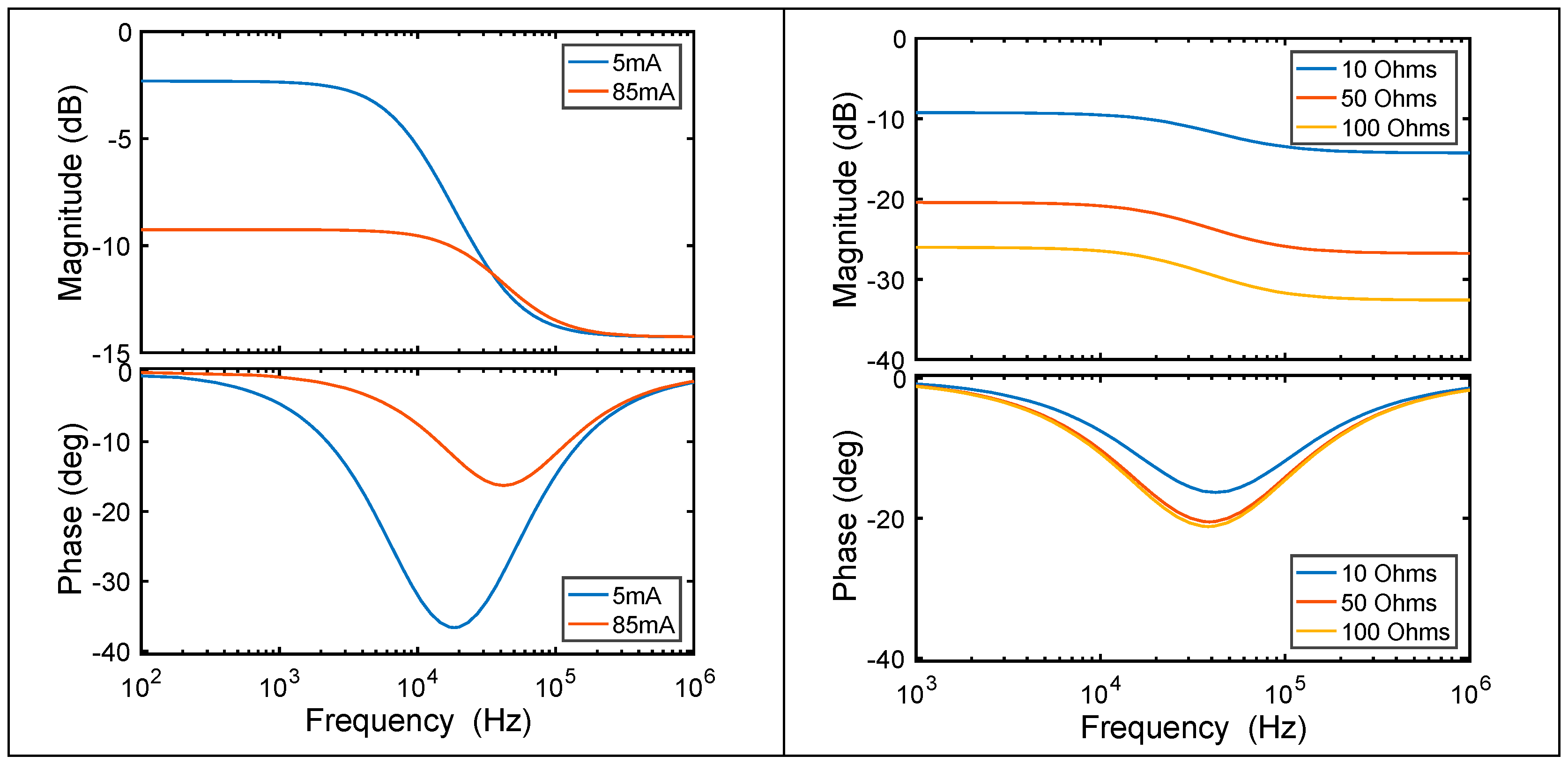
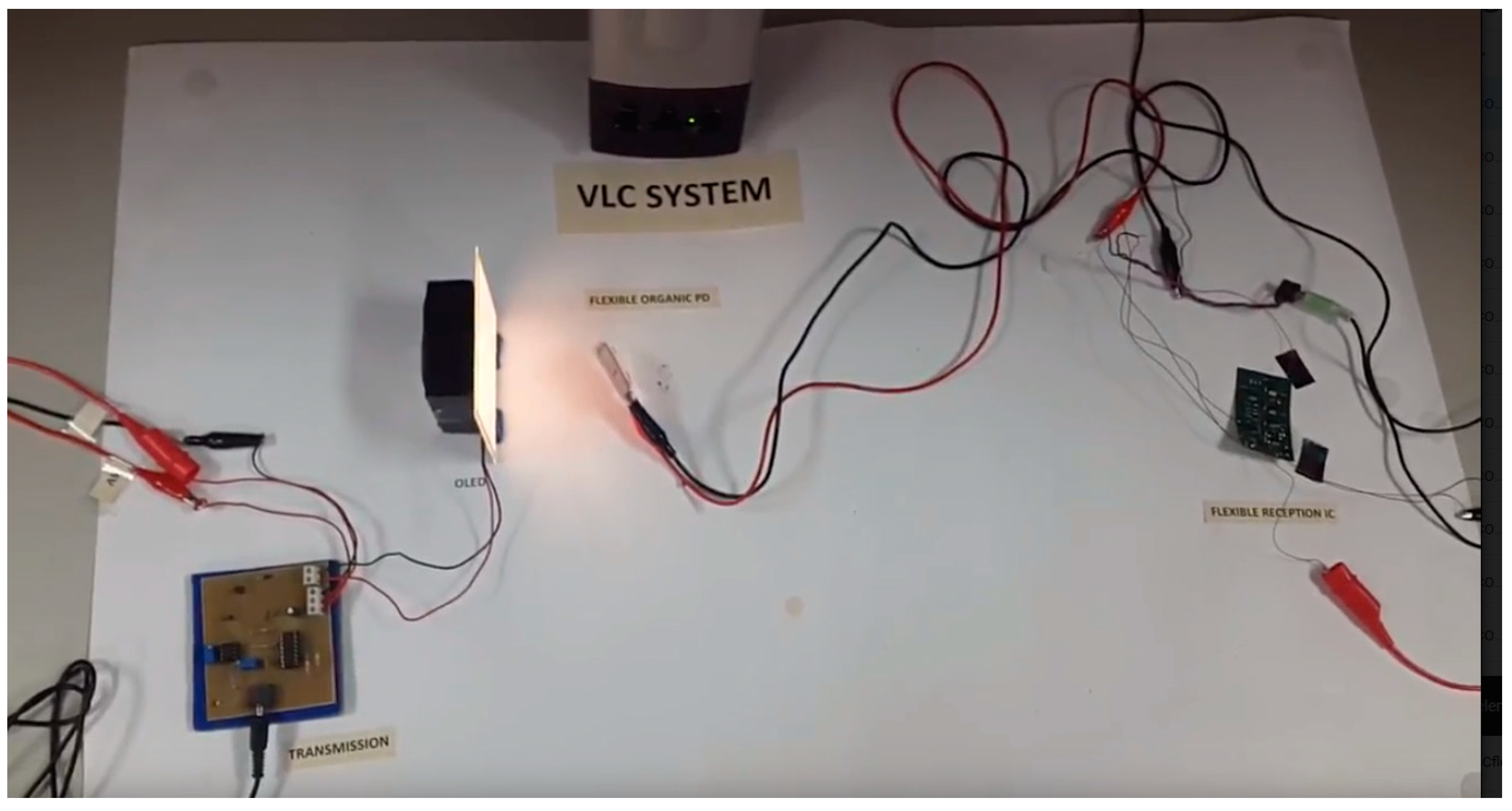
© 2018 by the authors. Licensee MDPI, Basel, Switzerland. This article is an open access article distributed under the terms and conditions of the Creative Commons Attribution (CC BY) license (http://creativecommons.org/licenses/by/4.0/).
Share and Cite
Vega-Colado, C.; Arredondo, B.; Torres, J.C.; López-Fraguas, E.; Vergaz, R.; Martín-Martín, D.; Del Pozo, G.; Romero, B.; Apilo, P.; Quintana, X.; et al. An All-Organic Flexible Visible Light Communication System. Sensors 2018, 18, 3045. https://doi.org/10.3390/s18093045
Vega-Colado C, Arredondo B, Torres JC, López-Fraguas E, Vergaz R, Martín-Martín D, Del Pozo G, Romero B, Apilo P, Quintana X, et al. An All-Organic Flexible Visible Light Communication System. Sensors. 2018; 18(9):3045. https://doi.org/10.3390/s18093045
Chicago/Turabian StyleVega-Colado, César, Belén Arredondo, Juan Carlos Torres, Eduardo López-Fraguas, Ricardo Vergaz, Diego Martín-Martín, Gonzalo Del Pozo, Beatriz Romero, Palvi Apilo, Xabier Quintana, and et al. 2018. "An All-Organic Flexible Visible Light Communication System" Sensors 18, no. 9: 3045. https://doi.org/10.3390/s18093045
APA StyleVega-Colado, C., Arredondo, B., Torres, J. C., López-Fraguas, E., Vergaz, R., Martín-Martín, D., Del Pozo, G., Romero, B., Apilo, P., Quintana, X., A. Geday, M., De Dios, C., & Sánchez-Pena, J. M. (2018). An All-Organic Flexible Visible Light Communication System. Sensors, 18(9), 3045. https://doi.org/10.3390/s18093045






